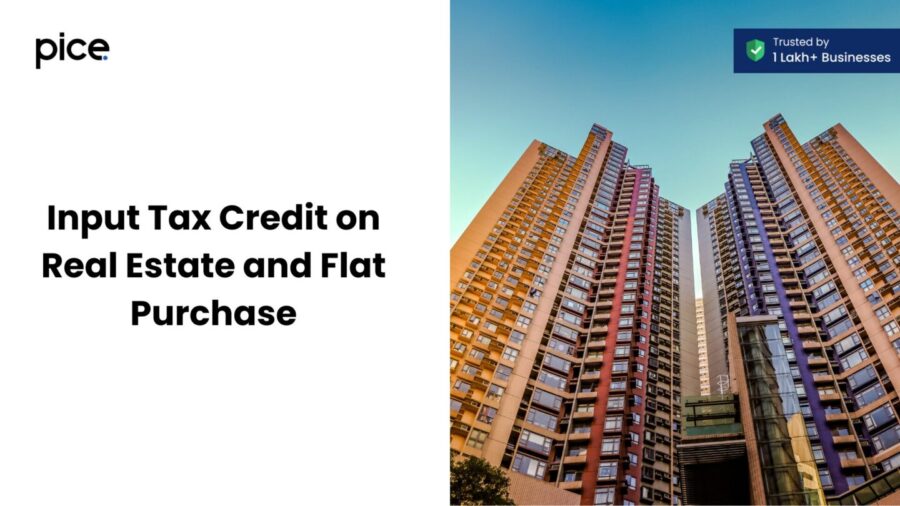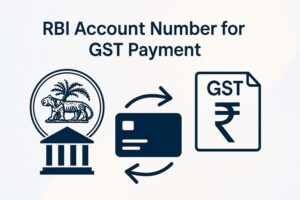Input Tax Credit on Real Estate and Flat Purchase
- 27 Aug 24
- 14 mins

Input Tax Credit on Real Estate and Flat Purchase
- What is Input Tax Credit?
- Input Tax Credit (ITC) in Real Estate
- Pre-GST Taxability of Real Estate Transactions
- GST Rates on Flat Purchases in India
- Impact of GST on Properties in India
- Calculation of GST on Flat Purchases
- Proposed Advantages of New GST Rates for Real Estate Sector
- Expected Impact of ITC Removal in Residential Real Estate
Key Takeaways
- Simplified Tax Structure: GST consolidates multiple taxes into a single tax system for real estate, reducing the overall tax burden and simplifying compliance.
- ITC Benefits: Real estate developers can claim ITC on GST paid for raw materials and input services, lowering construction costs and property prices.
- Affordable Housing: GST rates for affordable housing projects are concessional, promoting homeownership and reducing the tax impact on buyers.
- Pre-GST Complexity: The pre-GST regime involved multiple indirect taxes, leading to higher costs and inefficiencies in the real estate sector.
- No ITC for Completed Properties: ITC is not available for ready-to-move-in flats sold after obtaining the completion certificate, only applicable to under-construction properties.
What is Input Tax Credit?
Input Tax Credit (ITC) is a crucial component of the GST framework that allows businesses to reduce their tax liability by claiming credit for the GST paid on inputs used in the production or supply of goods and services. Essentially, ITC ensures that the tax is only levied on the value addition at each stage of the supply chain, preventing the cascading effect of taxes.
Under the GST regime, a registered person can claim ITC on the GST paid for goods or services used for business purposes. The credit is available if the goods or services are used for taxable supplies, exports, or supplies to SEZ units or developers. To claim ITC, businesses must possess a valid tax invoice or debit note, and the supplier must have uploaded the details in their GST returns.
The benefit of ITC is not available for certain items, such as personal expenses, goods or services used for exempt supplies, and items specified under Section 17(5) of the CGST Act. Proper documentation and compliance with GST regulations are essential for claiming ITC. Businesses must file valid GST returns and ensure that all conditions for availing ITC are met.
Input Tax Credit (ITC) in Real Estate
In the real estate sector, ITC plays a significant role in reducing the overall cost of construction and enhancing profitability. Real estate developers can claim ITC on the GST paid for raw materials, input services, and capital goods used in construction projects. This includes items like cement, steel, construction equipment, and professional services.
Before the introduction of GST, the real estate sector faced multiple indirect taxes such as VAT, Service Tax, and Excise Duty, which often led to higher costs and tax inefficiencies. With GST, these taxes were subsumed, and a single tax rate applies, simplifying the tax structure and providing clarity.
For real estate transactions, ITC can be claimed if the property is under construction and the developer is selling the units before the issuance of the completion certificate. However, ITC is not available for completed properties or ready-to-move-in flats where the sale occurs after obtaining the completion certificate.
Real estate developers must maintain accurate records and ensure compliance with GST regulations to claim ITC. This includes filing regular GST returns, maintaining purchase invoices, and reconciling ITC claims with the details available on the GST portal. Proper ITC management can lead to significant cost savings and competitive pricing for residential properties.
Pre-GST Taxability of Real Estate Transactions
Before the implementation of GST, the tax structure for real estate transactions was complex and varied across states. The primary taxes included VAT, Service Tax, and Luxury Tax, which were levied by state and central governments. Additionally, stamp duty and registration charges were applicable, further complicating the tax burden.
VAT was imposed on the sale of goods involved in construction, while Service Tax was levied on services provided by real estate developers. The rates varied significantly, leading to inconsistencies and higher property prices. Developers faced difficulties in managing multiple tax compliances, and the lack of uniformity often resulted in legal disputes.
Service Tax was applicable on construction services provided by developers, and the rate was typically 15%. However, developers could not claim credit for the Service Tax paid on input services, leading to a higher overall cost of construction. Similarly, VAT rates varied from state to state, creating discrepancies and increasing the compliance burden.
The pre-GST tax regime did not allow seamless credit flow, resulting in a cascading effect of taxes. This inefficiency led to higher property prices, impacting the affordability of residential properties. The introduction of GST aimed to address these issues by bringing a uniform tax structure and enabling the benefit of ITC.
GST Rates on Flat Purchases in India
Under the GST regime, the rates applicable to flat purchases vary based on the type of property and its value. For residential properties, the GST rates are as follows:
- Affordable Housing Projects: For affordable housing projects, the GST rate is 1% without ITC. This category includes projects where the carpet area of a residential apartment does not exceed 60 square meters in metropolitan cities and 90 square meters in non-metropolitan cities. Additionally, the property price should not exceed INR 45 lakh.
- Non-Affordable Housing: For other residential properties, the GST rate is 5% without ITC. This applies to residential apartments that do not fall under the affordable housing segment.
- Under-Construction Properties: GST is applicable on the sale of under-construction properties or those where the completion certificate has not been issued. The GST rates for these properties are based on whether they fall under the affordable housing segment or not.
- Completed Properties: No GST is applicable on the sale of completed properties or ready-to-move-in flats where the sale occurs after obtaining the completion certificate. However, stamp duty and registration charges are still applicable.
These GST rates have been introduced to promote the housing sector and make residential properties more affordable. The government has also provided concessional rates for affordable housing projects to encourage homeownership among middle and lower-income groups.
Impact of GST on Properties in India
The implementation of GST has had a significant impact on the real estate sector in India, affecting buyers, developers, and other stakeholders.
Impact on Buyers
For property buyers, GST has brought more transparency and simplicity in the taxation process. The uniform GST rates have replaced the multiple taxes previously levied, making it easier for buyers to understand the overall tax liability. The benefit of ITC available to developers can lead to lower property prices, as the tax savings can be passed on to buyers.
However, the removal of ITC for under-construction properties has been a point of contention. While it simplifies the tax structure, it also means that developers cannot claim credit for the GST paid on inputs, which can increase the overall cost of construction. This cost may be passed on to buyers, impacting property prices.
Buyers of completed properties benefit from the fact that no GST is applicable on such transactions, reducing the overall cost. However, stamp duty and registration charges remain applicable, which can add to the total property cost.
Impact on Developers, Builders, and Contractors

For developers, builders, and contractors, the introduction of GST has simplified the tax structure by consolidating multiple taxes into a single tax rate. The ability to claim ITC on inputs used in construction helps reduce the overall cost of construction, making projects more financially viable.
The uniform tax rates under GST have reduced the compliance burden for developers, as they no longer need to manage multiple tax filings for different taxes. This has led to improved efficiency and better financial management in real estate projects.
However, the removal of ITC for under-construction properties means that developers cannot claim credit for the GST paid on inputs. This can increase the cost of construction and impact the pricing of residential properties. Developers need to carefully manage their costs and pricing strategies to remain competitive in the market.
Impact on Other Stakeholders
Other stakeholders in the real estate sector, such as contractors, suppliers, and service providers, have also been affected by the implementation of GST. The ability to claim ITC on goods and services used in construction has reduced their tax liability, leading to potential cost savings.
Contractors and suppliers benefit from the streamlined tax structure and reduced compliance burden under GST. The uniform tax rates and the ability to claim ITC help improve cash flow and financial management in construction projects.
Service providers, such as architects, engineers, and consultants, also benefit from the uniform tax rates and the ability to claim ITC on input services. This has led to improved efficiency and reduced costs in providing construction-related services.
Calculation of GST on Flat Purchases
The calculation of GST on flat purchases depends on several factors, including the type of property, its value, and whether it falls under the affordable housing segment. Here’s how GST is calculated on flat purchases:
- Determine the Property Type: Identify whether the property is a residential apartment, commercial apartment, or part of an affordable housing project. The type of property will determine the GST rate applicable.
- Identify the GST Rate: Based on the property type, apply the relevant GST rate. For affordable housing projects, the GST rate is 1% without ITC. For other residential properties, the GST rate is 5% without ITC.
- Calculate the Taxable Value: The taxable value is the total consideration for the property, excluding stamp duty and registration charges. It includes the cost of construction, common facility charges, and other related expenses.
- Apply the GST Rate: Multiply the taxable value by the applicable GST rate to determine the GST amount. For example, if the taxable value of a residential apartment is INR 50 lakh and the GST rate is 5%, the GST amount will be INR 2.5 lakh.
- Consider ITC: If ITC is available, it can be claimed against the GST liability, reducing the overall tax burden. However, for properties where ITC is not available, the full GST amount must be paid.
- Include Additional Costs: Consider any additional costs, such as stamp duty and registration charges, which are not covered under GST but are part of the total property cost.
By following these steps, buyers and developers can accurately calculate the GST liability on flat purchases, ensuring compliance with GST regulations and optimizing tax benefits.
Proposed Advantages of New GST Rates for Real Estate Sector
The introduction of new GST rates for the real estate sector aims to provide several advantages, including increased transparency, reduced tax burden, and improved affordability of residential properties.
- Increased Transparency: The uniform GST rates have replaced the multiple taxes previously levied, making the taxation process more transparent and easier to understand for both buyers and developers.
- Reduced Tax Burden: The concessional GST rates for affordable housing projects help reduce the overall tax burden on buyers, making homes more affordable. The availability of ITC for developers on inputs used in construction further reduces the cost of construction.
- Improved Affordability: The reduced tax burden and the benefit of ITC can lead to lower property prices, making residential properties more affordable for middle and lower-income groups.
- Encouragement of Homeownership: The government’s focus on promoting affordable housing projects through concessional GST rates encourages homeownership among first-time buyers and those in lower-income segments.
- Boost to Real Estate Sector: The simplified tax structure and reduced compliance burden under GST have boosted the real estate sector, encouraging more investments and growth in the industry.
By leveraging these advantages, the real estate sector can enhance its growth prospects, improve affordability for buyers, and contribute to the overall development of the housing sector in India.
Expected Impact of ITC Removal in Residential Real Estate
The removal of ITC for residential real estate projects has both positive and negative impacts on the industry. While it simplifies the tax structure, it also presents challenges for developers in managing costs and pricing.
- Simplified Tax Structure: The removal of ITC simplifies the tax structure for residential real estate projects, making it easier for developers to comply with GST regulations. It eliminates the need for maintaining detailed records of ITC claims and reconciliations.
- Increased Cost of Construction: Without ITC, developers cannot claim credit for the GST paid on inputs used in construction. This increases the overall cost of construction, which may be passed on to buyers in the form of higher property prices.
- Impact on Property Prices: The increased cost of construction due to the removal of ITC can lead to higher property prices, impacting the affordability of residential properties. Developers need to carefully manage their pricing strategies to remain competitive.
- Potential for Cost Savings: Developers may need to explore alternative cost-saving measures, such as bulk procurement of raw materials and efficient project management, to mitigate the impact of ITC removal.
- Focus on Affordable Housing: The removal of ITC may encourage developers to focus more on affordable housing projects, where the GST rates are concessional, and the overall tax burden is lower.
Overall, the removal of ITC presents both opportunities and challenges for the residential real estate sector. Developers need to adapt to the new tax structure and explore innovative ways to manage costs and pricing, ensuring that they remain competitive in the market.
 By
By 
















